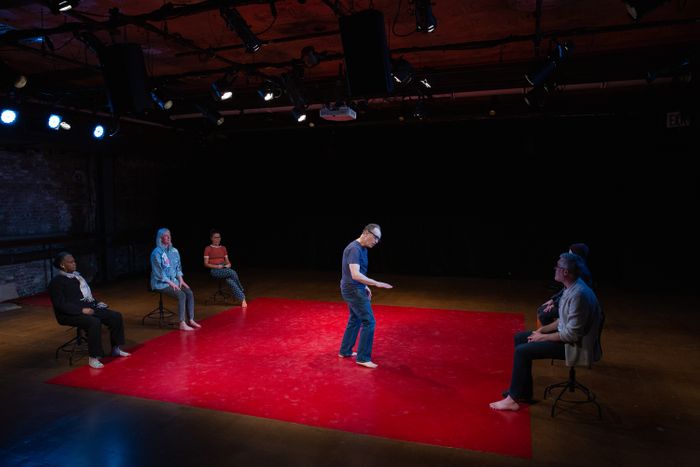
In 1958, the composer John Cage gave a lecture in Brussels. A raconteur, he often told little stories during his performances; this time he made his tales the entire talk, prolonging or hastening the telling of each one to take exactly a minute. In Brussels, he delivered 30 stories in 30 minutes; later in the U.S., he expanded the set to 90, performing it alongside a David Tudor composition. Instead of holding forth on chance-based operations or musical theory, Cage’s texts are droll half-parables, gathered as he studied Zen, or gave talks, or hunted for mushrooms. (You can hear Cage and Tudor performing Indeterminacy here; Eddie Kohler turned the stories into an app here.) Though they often address purposelessness, there is a current in them that carries you towards delight and alertness.
Two monks … were walking along one day when they came to a stream where a young lady was waiting, hoping that someone would help her across. Without hesitating, one of the monks picked her up and carried her across, putting her down safely on the other side. The two monks continued walking along, and after some time, the second one, unable to restrain himself, said to the first, “You know we’re not allowed to touch women. Why did you carry that woman across the stream?” The first monk replied, “Put her down. I did — two hours ago.”
For several years now, Paul Lazar has been performing Cage Shuffle, a warm-spirited retelling of some of Cage’s Indeterminacy pieces, by loading them onto a phone that scrambles their order. Cued by his earpiece, Lazar doesn’t know which one will come next; as he recites the stories, he dances. Choreographer Annie-B Parson has built him a long sequence of her trademark vernacular movement: Lazar points, taps his elbow, goes to the back of the theater to do a bunnyhop, does an S-shaped wiggle that looks like a man trying to coil a stiff rope. The stories are randomized, but the movement is always the same. In Cage Shuffle Marathon, now at La MaMa, Lazar finally performs all 90 stories, aided by six guests (including major downtown figures like Jess Barbagallo and Sheryl Sutton) who chip in for a single story each. For instance, the night I saw it, Jennifer Krasinski stood up, did a gesture like unzipping a secret pocket, and:
It was a Wednesday. I was in the sixth grade. I overheard Dad saying to Mother, “Get ready: Wwe’re going to New Zealand Saturday.” I got ready. I read everything I could find in the school library about New Zealand. Saturday came. Nothing happened. The project was not even mentioned, that day or any succeeding day.
Parson’s choreography, which she also performs for one sequence, underlines the texts. Rather, I should say, the dance italicizes them: It emphasizes them by leaning. Her work trains our eyes to see everyday movement as dance; Cage trains our ears to hear everyday language as music. (There’s also a very cute fingertip-applause gesture, which magically always seems to come right on a punch line.) As Lazar dances, even though his moves seem simple, he tuckers himself out. He sweats (the downstairs space at La MaMa is reliably warm), and the collar of his shirt darkens. Does it matter which sequence he tells the stories in? It doesn’t seem to, but the fact that they are in a sequence, with a given duration, does. We see his expense of effort on the project, and this evidence of his labor helps engrave this glancing, unpretentious experience onto our memories.
An old rabbi in Poland or someplace thereabouts was walking in a thunderstorm from one village to another. His health was poor. He was blind, covered with sores. All the afflictions of Job were his. Stumbling over something, he fell in the mud. Pulling himself up with difficulty, he raised his hands towards heaven and cried out, “Praise God! The Devil is on Earth and doing his work beautifully!
Cage, in recordings, was charming; Lazar, goofing around in his rolled-up jeans, is super-charming. Every part of his performance is suffused with the sense that he’s discovering things in real time. He giggles when there’s a serendipitous juxtaposition, delighted, for example, when he finds himself talking about a car while also doing a move like shifting into third. I was struck when he told a story about a jukebox while also patting his chest — the two things happening at the same moment felt meaningful (Lazar is basically treating himself like a Cage jukebox), but we also know that the moment must be a coincidence. Is there a difference? Not really. Cage suggests that accident and purpose aren’t oppositional concepts, not when everything — treated with attention — can instruct us. That’s enough of a philosophy to build a church upon, and certainly Cage Shuffle Marathon feels at times like a lighthearted sermon. Today’s liturgy: the pleasures of meticulousness and surrender. But don’t take Lazar’s word for it! Shuffle the stories again, and you’ll discover tomorrow’s liturgy for yourself.
Cage Shuffle Marathon is at La MaMa through February 19.


